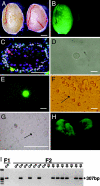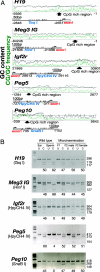Rats produced by interspecies spermatogonial transplantation in mice and in vitro microinsemination
- PMID: 16945902
- PMCID: PMC1564227
- DOI: 10.1073/pnas.0604205103
Rats produced by interspecies spermatogonial transplantation in mice and in vitro microinsemination
Abstract
Spermatogonial transplantation has demonstrated a unique opportunity for studying spermatogenesis and provided an assay for spermatogonial stem cells. However, it has remained unknown whether germ cells that matured in a xenogeneic environment are functionally normal. In this investigation, we demonstrate the successful production of xenogeneic offspring by using spermatogonial transplantation. Rat spermatogonial stem cells were collected from immature testis and transplanted into the seminiferous tubules of busulfan-treated nude mouse testis. Using rat spermatids or spermatozoa that developed in xenogeneic surrogate mice, rat offspring were born from fresh and cryopreserved donor cells after microinsemination with rat oocytes. These offspring were fertile and had a normal imprinting pattern. The xenogeneic offspring production by interspecies germ cell transplantation and in vitro microinsemination will become a powerful tool in animal transgenesis and species conservation.
Conflict of interest statement
Conflict of interest statement: No conflicts declared.
Figures


Similar articles
-
Production of transgenic rats via lentiviral transduction and xenogeneic transplantation of spermatogonial stem cells.Biol Reprod. 2008 Dec;79(6):1121-8. doi: 10.1095/biolreprod.108.071159. Epub 2008 Aug 6. Biol Reprod. 2008. PMID: 18685123
-
Recipient preparation is critical for spermatogonial transplantation in the rat.Tissue Cell. 1999 Oct;31(5):461-72. doi: 10.1054/tice.1999.0060. Tissue Cell. 1999. PMID: 10612257
-
Irradiated mouse testes efficiently support spermatogenesis derived from donor germ cells of mice and rats.J Androl. 2006 May-Jun;27(3):365-75. doi: 10.2164/jandrol.05179. Epub 2005 Dec 8. J Androl. 2006. PMID: 16339450
-
Spermatogonial stem cell transplantation, cryopreservation and culture.Semin Cell Dev Biol. 1998 Aug;9(4):401-9. doi: 10.1006/scdb.1998.0205. Semin Cell Dev Biol. 1998. PMID: 10366284 Review.
-
Germ cell transplantation and testis tissue xenografting in domestic animals.Anim Reprod Sci. 2005 Oct;89(1-4):137-45. doi: 10.1016/j.anireprosci.2005.06.020. Anim Reprod Sci. 2005. PMID: 16055282 Review.
Cited by
-
Reprogramming and development in nuclear transfer embryos and in interspecific systems.Curr Opin Genet Dev. 2012 Oct;22(5):450-8. doi: 10.1016/j.gde.2012.09.002. Epub 2012 Oct 11. Curr Opin Genet Dev. 2012. PMID: 23062626 Free PMC article. Review.
-
Spermatogonial stem cells.Biol Reprod. 2018 Jul 1;99(1):52-74. doi: 10.1093/biolre/ioy077. Biol Reprod. 2018. PMID: 29617903 Free PMC article. Review.
-
Sperm bauplan and function and underlying processes of sperm formation and selection.Physiol Rev. 2022 Jan 1;102(1):7-60. doi: 10.1152/physrev.00009.2020. Epub 2021 Apr 21. Physiol Rev. 2022. PMID: 33880962 Free PMC article. Review.
-
Spermatogonial stem cell technologies: applications from human medicine to wildlife conservation†.Biol Reprod. 2024 Oct 14;111(4):757-779. doi: 10.1093/biolre/ioae109. Biol Reprod. 2024. PMID: 38993049 Free PMC article. Review.
-
Derivation of embryonic stem cell lines from parthenogenetically developing rat blastocysts.Stem Cells Dev. 2014 Jan 15;23(2):107-14. doi: 10.1089/scd.2013.0200. Epub 2013 Nov 7. Stem Cells Dev. 2014. PMID: 24010570 Free PMC article.
References
-
- de Rooij DG, Russell LD. J Androl. 2000;21:776–798. - PubMed
-
- Meistrich ML, van Beek MEAB. In: Cell and Molecular Biology of the Testis. Desjardins C, Ewing LL, editors. New York: Oxford Univ. Press; 1993. pp. 266–295.
Publication types
MeSH terms
LinkOut - more resources
Full Text Sources
Other Literature Sources

